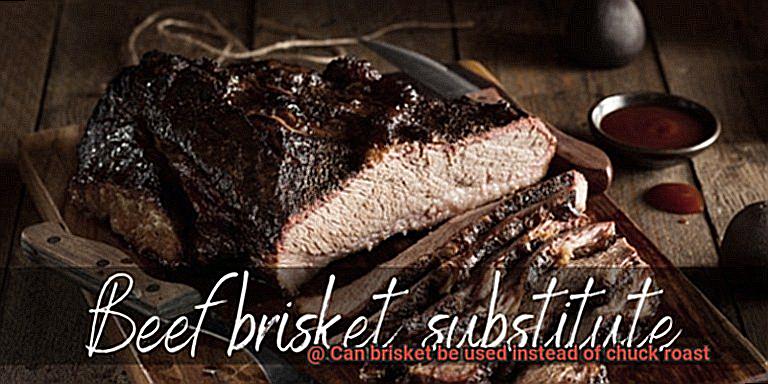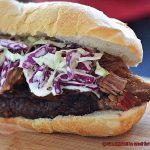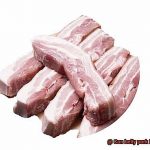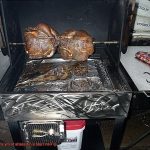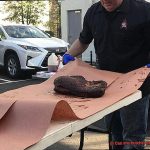Are you tired of the same old beef roast recipe, and looking to mix things up a bit? Maybe you’ve heard of the mouthwatering and flavorful brisket, but are wondering if it can replace your trusty chuck roast. The answer is a resounding yes.
While both cuts come from the shoulder area of the cow, they have distinct differences that can affect your dish’s final outcome. Brisket boasts a rich, savory flavor and tender texture when cooked low and slow. Meanwhile, chuck roast tends to be leaner with a more robust beefy taste. So, can one cut substitute for the other?
In this post, we’ll explore the similarities and differences between brisket and chuck roast while uncovering how to use brisket as an excellent replacement in your favorite beef recipes. We’ll also share some cooking methods that work best for each cut of meat and provide tips and tricks for achieving a perfect dish bursting with flavor. Whether you’re an experienced cook or just starting to experiment with different meats, this guide on using brisket instead of chuck roast is not one to miss. Let’s dive in.
Contents
What is Brisket?
This tough yet flavorful cut is known for its rich and juicy taste, making it a popular choice for barbecue and smoking. Brisket is also the star ingredient in classic dishes like pastrami and corned beef.
One of the reasons why brisket is so highly sought after is its unique flavor profile. Brisket boasts a deep, beefy flavor that is further enhanced by its higher fat content. This added fat provides a moist and juicy texture that melts in your mouth, but it also requires longer cooking times to break down the fat and connective tissue for a tender result.
The brisket is made up of two main muscles: the flat and the point. The flat is a leaner cut that is more uniform in shape, while the point is fattier and has a more irregular shape. When cooked together, these two muscles create a juicy, flavorful cut of meat that has been tantalizing taste buds for generations.
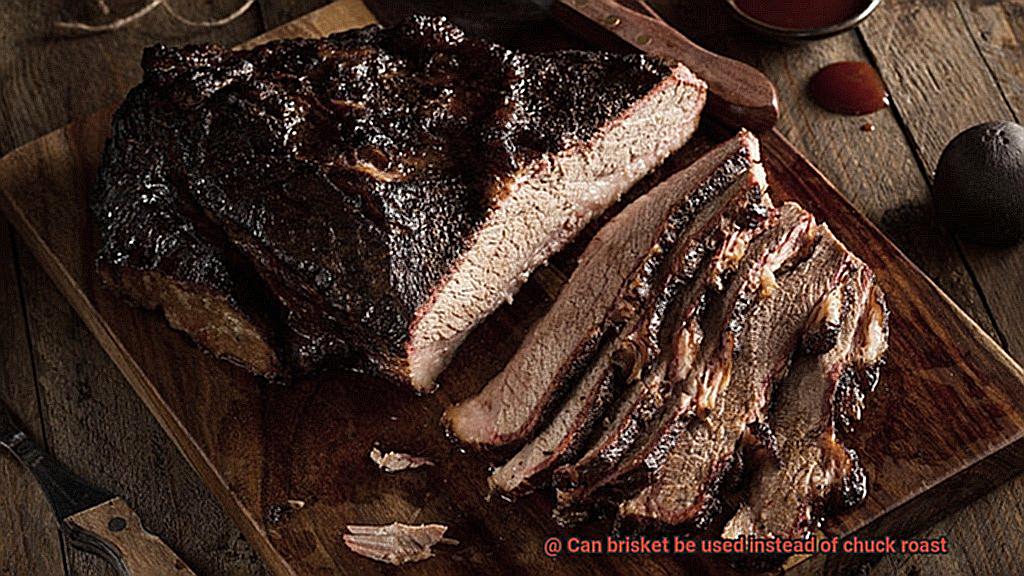
To cook brisket, many people choose to smoke or slow-cook it to achieve maximum tenderness and flavor. Smoking allows the meat to cook slowly over indirect heat, resulting in a perfectly cooked brisket with smoky undertones. It’s essential to use indirect heat when smoking or grilling brisket to prevent overcooking or uneven cooking.
While brisket can be used instead of chuck roast for grilling, there are some differences to keep in mind. The size and shape of brisket can vary, which may affect cooking times and methods. Adjusting cooking times accordingly and using indirect heat can help ensure a delicious result.
What is Chuck Roast?
This cut of beef comes from the shoulder area of a cow and is a popular choice for slow-cooking methods like roasting, braising, and stewing. The reason for this is simple: chuck roast has a rich flavor and a tender texture that results in melt-in-your-mouth goodness.
One unique aspect of chuck roast is its appearance. It’s typically sold as a large rectangular-shaped piece with layers of fat throughout. But don’t let the fat scare you off. This actually helps keep the meat moist during cooking and adds flavor to the final dish. Plus, the marbled appearance of the cut adds to its overall appeal.
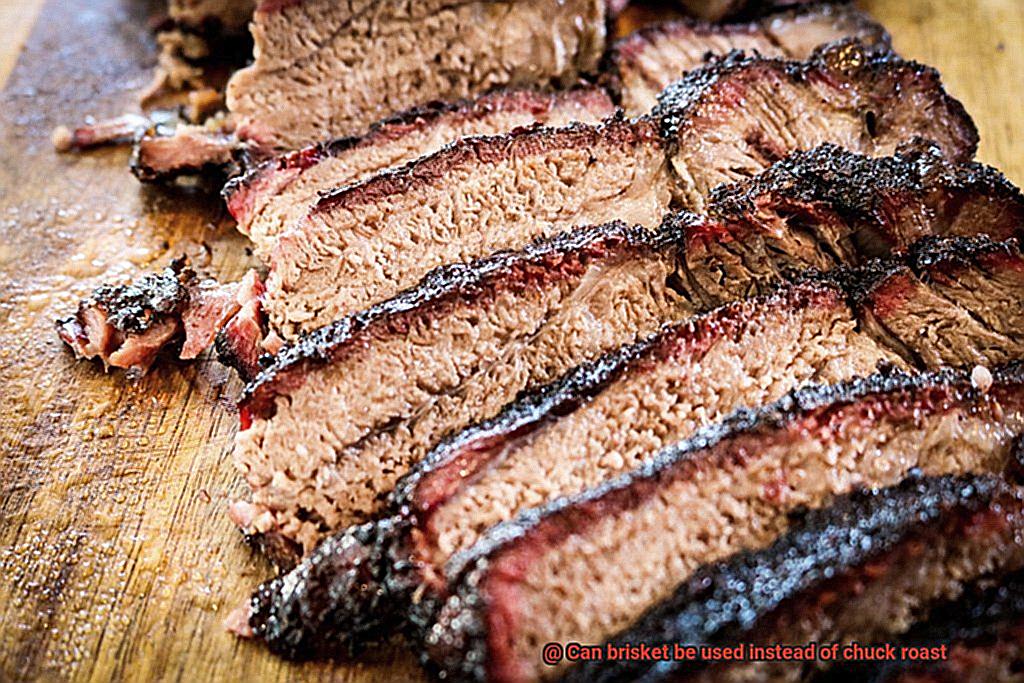
When shopping for chuck roast, it’s important to look for a piece with good marbling and even coloring. Darker meat can indicate that the cow was older when it was slaughtered, which can result in tougher meat. So make sure to select a piece that has a nice balance of fat and meat.
The versatility of chuck roast is another reason why it’s so popular. Pot roast is a classic choice, but you could also use it in beef stews or shred it up for sandwiches. Experiment with different spices and seasonings to find your favorite flavor combinations. Here are some dishes where using Chuck Roast would be great:
- Classic Pot Roast
- Beef Stew
- Shredded Beef Sandwiches
- Slow-Cooked Chili
- Barbacoa Beef Tacos
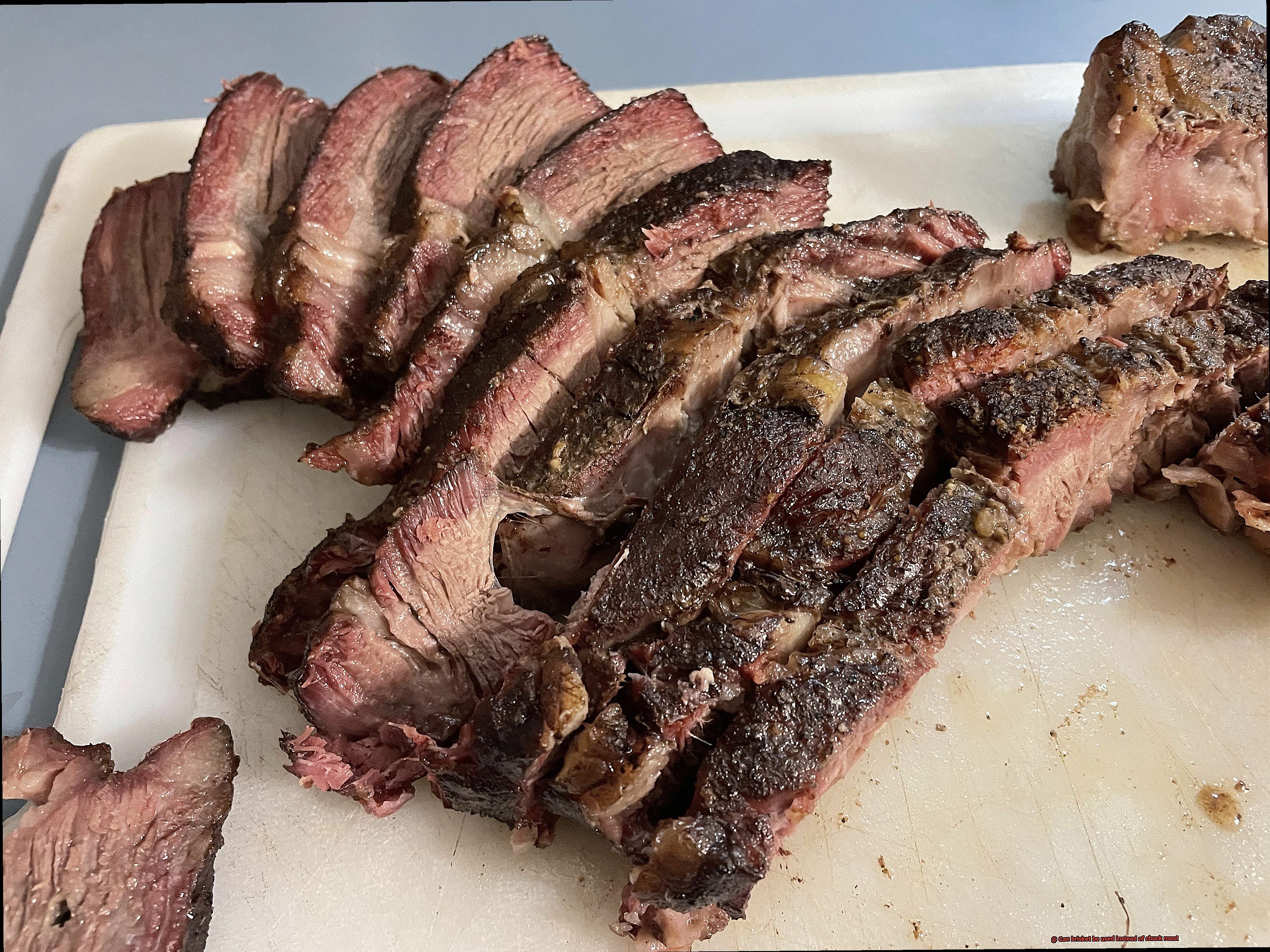
Differences Between Brisket and Chuck Roast
You’ve likely encountered the two popular cuts of beef, brisket and chuck roast. While they may look similar, there are crucial differences that set them apart. As an expert on the topic, let me break it down for you.
First and foremost, location matters. Brisket comes from the lower chest area of the cow, while chuck roast comes from the shoulder. Because of this, brisket has more connective tissue, which can make it tough if not cooked correctly. Conversely, chuck roast has more marbling, adding flavor and moisture to the meat.
Appearance is another distinguishing factor. Brisket is a long, flat cut with two distinct muscles – the point and the flat – while chuck roast is rounder with a bone in the center and a layer of fat on top. The fat in the chuck roast contributes to its juiciness and flavor.
When it comes to cooking methods, both brisket and chuck roast can be grilled or smoked, but they require different techniques. Brisket is typically smoked low and slow for several hours to break down the tough connective tissue and render the fat for a tender, juicy result. Chuck roast can be cooked low and slow but also benefits from braising or roasting to unlock its full flavor potential.
To summarize, brisket and chuck roast have some similarities but are different cuts of beef that demand different cooking methods. While brisket requires careful attention to prevent toughness, chuck roast requires proper rendering of its fat to maximize its flavor. With this knowledge in hand, you’ll be well-equipped to select the perfect cut of beef for your next grilling extravaganza.
Advantages of Using Brisket Instead of Chuck Roast
Are you ready to elevate your BBQ game and try something new? Look no further than brisket. Not only is it a delicious cut of meat, but it also offers several advantages over the popular choice of chuck roast.
First and foremost, let’s talk flavor. Brisket boasts a rich, beefy taste that is hard to beat. With fat marbling throughout the meat, it stays tender and juicy during the cooking process, resulting in a flavor explosion with every bite. Chuck roast, on the other hand, can be leaner and less flavorful in comparison.
But the advantages don’t stop there. Brisket is incredibly versatile when it comes to cooking methods. It can be smoked, slow-cooked, or braised, allowing for endless experimentation with different flavors and techniques. Chuck roast may not offer the same level of versatility.
And what about affordability? Believe it or not, brisket can be more budget-friendly than chuck roast in some cases. Since brisket typically comes in larger cuts, it can be divided into multiple meals or used for leftovers. Chuck roast may have a higher price point per pound and may not offer as much value in terms of portions or leftovers.
Considerations When Using Brisket Instead of Chuck Roast
If you’re looking to shake up your BBQ routine, swapping out chuck roast for brisket can be a game-changer. However, before you dive in, there are a few things to consider.
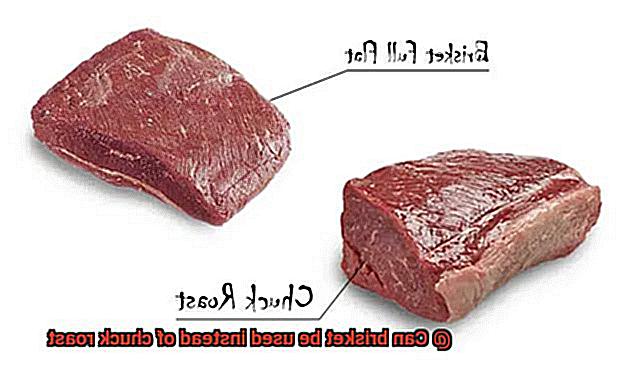
First off, brisket is a tougher cut of meat than chuck roast, meaning it requires a longer cooking time and lower temperature to achieve the desired tenderness. This may require some extra patience and attention, but the resulting melt-in-your-mouth texture is worth the effort.
In terms of flavor, brisket has a distinct beefy and smoky taste that sets it apart from the more neutral flavor profile of chuck roast. Depending on your recipe or personal preference, this can be either an advantage or a drawback.
Another factor to keep in mind is fat content. Brisket tends to have more fat than chuck roast, which can render down during cooking and add moisture and flavor to the meat. However, if not managed properly, the excess fat can also cause flare-ups on the grill or smoker.
Finally, cost is also a consideration. Brisket is typically pricier than chuck roast, so it may not always be the most cost-effective choice. However, if you’re willing to invest a little extra money and effort into your BBQ game, the delicious results speak for themselves.
Cooking Times for Brisket vs Chuck Roast
Maybe you’re thinking of switching from brisket to chuck roast (or vice versa). But before you do, let’s go over the differences in cooking times between these two cuts of meat.
First, let’s talk about brisket. This thick, tough cut of meat requires patience and attention to achieve that mouthwatering smoky flavor we all love. It needs to be cooked low and slow over a long period, which means planning ahead and allowing anywhere from 8-12 hours for cooking time depending on the size of the cut and cooking method used. The best way to cook brisket is with indirect heat, either in a smoker or oven, at around 225°F. Keep an eye on the internal temperature, and once it reaches 195°F to 205°F, your brisket is ready to devour.
Now onto chuck roast. This cut of meat is leaner and more tender than brisket, making it perfect for roasting or braising. Unlike brisket, chuck roast won’t take up your entire day – it can be cooked in just 2-3 hours in the oven at 350°F or braised on the stovetop for around 2 hours. Just be sure to keep an eye on the internal temperature; medium-rare chuck roast should reach 145°F while well-done should be cooked until it reaches 170°F.
But why do these two cuts differ so much in cooking time? It all comes down to the specific characteristics of the meat. Brisket is a tougher cut because it comes from the chest area of the cow, which means there’s a lot of connective tissue that needs to be broken down through slow cooking. On the other hand, chuck roast comes from the shoulder area of the cow, which is a bit more tender and requires less cooking time.
Best Cooking Methods for Each Cut of Meat
As a meat connoisseur, it is crucial to understand the art of cooking each cut of meat to perfection. Different cuts of meat require distinct cooking techniques to achieve mouth-watering results. In this article, we will delve into the best cooking methods for two popular beef cuts: brisket and chuck roast.
Brisket is a favorite among BBQ enthusiasts for its unmatched flavor and tender texture when cooked correctly. The key to cooking brisket is to smoke or slow-roast it over low heat for several hours until it reaches an internal temperature of 195-205°F. This low and slow cooking method breaks down the tough connective tissues in the meat, resulting in a delectable and juicy dish that makes your taste buds dance. To elevate the beefy taste, use a dry rub that complements the brisket’s flavor.
Chuck roast, on the other hand, is a versatile cut that can be used in various dishes, including stews, pot roasts, and braised dishes. It has a slightly more pronounced beef flavor than brisket and can be cooked using moist or dry heat methods depending on the desired outcome. If you opt for moist heat methods, you can sear it and then cook it in a Dutch oven with vegetables and broth until it becomes tender and bursting with flavor.
When preparing chuck roast, it is crucial to keep an eye on its internal temperature as overcooking can make it tough and dry. Use a meat thermometer and remove the roast from heat when it reaches an internal temperature of 145°F to avoid disappointment.
Tips for Choosing High-Quality Cuts of Meat
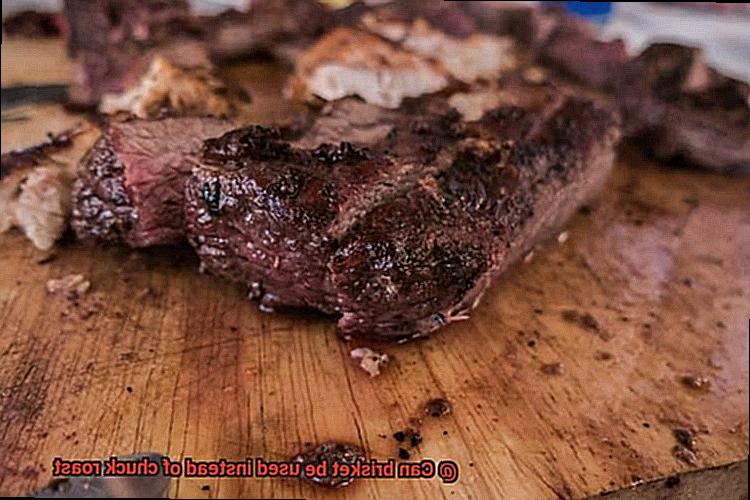
Grilling is a beloved pastime for many, but the secret to achieving mouth-watering meat lies in selecting high-quality cuts. Here are some expert tips for choosing the best cuts of meat for grilling.
Look for Marbling
Marbling is the white streaks of fat within the muscle fibers that keep the meat tender and juicy during cooking. Meat with a good amount of marbling throughout will result in a more flavorful and tender grilled dish. However, be careful not to choose meat with too much fat, as this can lead to flare-ups on the grill.
Consider the Age of the Animal
The age of the animal from which the meat was sourced can affect its tenderness. Younger animals tend to have more tender meat than older animals. When selecting beef, opt for cuts from younger cows, as they are more likely to have tender meat than beef from older cows.
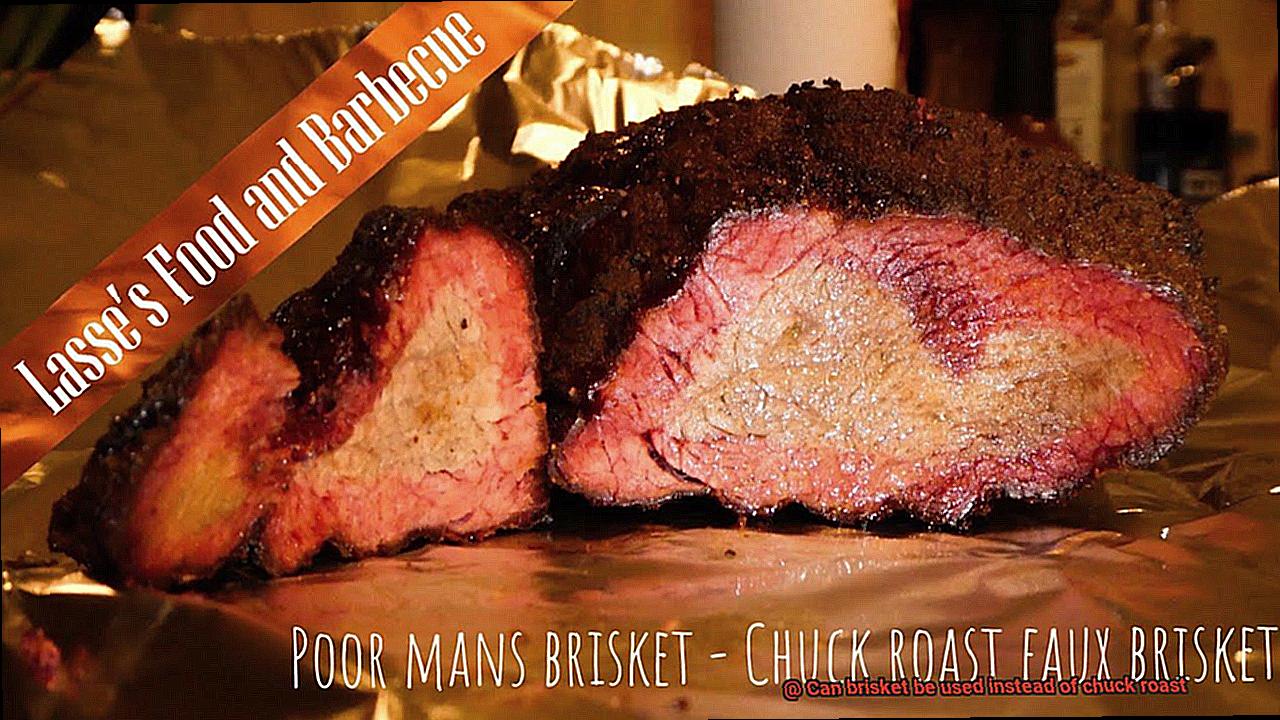
Choose Properly Trimmed Meat
Properly trimmed meat has excess fat and connective tissue removed, leaving only the most tender parts of the meat. This ensures that your meat cooks evenly on the grill and results in a more tender result. Proper trimming also ensures that any marinades or rubs you apply will penetrate the meat evenly.
Pay Attention to Color
The color of your meat can indicate its freshness and quality. Beef should be a bright red color, indicating its freshness. If the meat appears brown or gray, it may be past its prime or improperly stored.
Check for Connective Tissue
Some cuts of meat, such as brisket and chuck roast, are known for their tough texture due to connective tissue. Look for cuts with less visible connective tissue, which will be easier to tenderize and cook evenly. Alternatively, consider using a slow-cooking method like smoking or braising to break down the connective tissue and create a tender result.
Consider Meat Grade
The USDA grades beef based on its level of marbling and maturity. Higher grades (Prime and Choice) will generally have more marbling and be more tender than lower grades (Select and Standard). While higher grades may come with a higher price tag, they can make all the difference in achieving a high-quality result when grilling.
8c90uiKloYc” >
Conclusion
In conclusion, if you want to elevate your beef roast game, brisket is an excellent alternative to chuck roast. Although both cuts come from the shoulder area of the cow, they offer distinctive differences that can impact your dish’s final taste and texture. Brisket boasts a mouth-watering, savory flavor and tender texture when cooked low and slow. In contrast, chuck roast tends to be leaner with a more robust beefy taste.
When substituting brisket for chuck roast, it’s crucial to keep in mind some differences in size and shape that may affect cooking times and methods. Adjusting cooking times accordingly and using indirect heat can help ensure a delicious result.
Moreover, brisket is incredibly versatile when it comes to cooking methods. It can be smoked, slow-cooked or braised, giving you endless opportunities to experiment with different flavors and techniques. Chuck roast may not offer the same level of versatility.
When selecting high-quality cuts of meat for grilling, look for marbling as it adds flavor and juiciness. Consider the age of the animal; younger animals tend to have more tender meat than older ones. Opt for properly trimmed meat as excess fat can lead to flare-ups on the grill. Pay attention to color as darker red meat indicates a higher pH level resulting in tougher meat. Lastly, check for connective tissue as this determines how tough or tender your cut will be.
Ultimately, whether you prefer brisket or chuck roast depends on personal preference.

